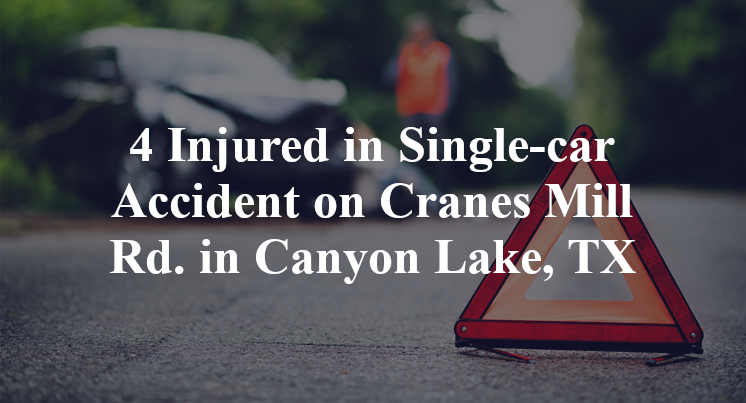4 Injured in Single-car Accident on Cranes Mill Rd. in Canyon Lake, TX
Comal County, TX — August 2, 2025, four people were injured due to a single-car accident at approximately 6:00 a.m. along Cranes Mill Road.
According to authorities, four people—two women ages 20 and 26 and two men who were both age 27—were traveling in a southwest bound Jeep Cherokee on Cranes Mill Road in the vicinity south of the Farm to Market 32 intersection when the accident took place.

Officials indicate that, for reasons yet to be confirmed, the Jeep was involved in a single-vehicle collision in which it apparently struck a tree. One of the 27-year-old male passengers reportedly sustained serious injuries over the course of the accident. The other three occupants of the Jeep suffered minor injuries, as well, reports state. Additional details pertaining to this incident—including the identities of the victims—are not available at this point in time. The investigation is currently ongoing.
Commentary by Attorney Michael Grossman
When several people are hurt in a single-vehicle crash, it’s tempting to assume the cause is straightforward. But a serious collision with a tree often points to something more complex than simply “losing control.” The real concern is whether investigators will take the time to ask questions that go deeper than the surface.
Did the authorities thoroughly investigate the crash?
A Jeep leaving the roadway and striking a tree should prompt investigators to reconstruct the vehicle’s path, examine tire marks, and determine whether the driver attempted evasive action. Were there signs of sudden braking? Did the vehicle drift or swerve sharply before impact? These details can distinguish between driver behavior and external or mechanical influences. Unfortunately, many single-vehicle crashes don’t get the same forensic attention as multi-vehicle collisions, leaving important questions unanswered.
Has anyone looked into the possibility that a vehicle defect caused the crash?
Jeep Cherokees, like many SUVs, rely on stability and steering systems that can fail in subtle ways. A steering lock, brake failure, or sudden suspension issue could easily explain why the vehicle veered off and struck a tree. Tire blowouts are another potential cause. Unless a full mechanical inspection is conducted before repairs or salvage, those factors may never come to light. Too often, the chance to uncover a defect is lost when the vehicle is quickly cleared from the scene.
Has all the electronic data relating to the crash been collected?
The Jeep almost certainly carries an event data recorder capable of storing speed, steering, braking, and throttle inputs in the seconds before the crash. Combined with GPS logs, nearby security or traffic cameras, and phone data, investigators could piece together exactly what happened. Without securing that information quickly, though, much of it may be overwritten or lost.
Crashes that injure multiple people in one vehicle don’t just raise questions about what happened in those final moments—they highlight how easily important evidence can disappear if no one insists on digging deeper.
Takeaways:
- A tree-strike collision should be reconstructed carefully to clarify whether evasive action was attempted.
- Mechanical failures like steering or brake issues could be hidden causes but require inspection to detect.
- Electronic crash data, GPS, and phone records can provide answers if secured promptly.

*We appreciate your feedback and welcome anyone to comment on our blog entries, however all visitor blog comments must be approved by the site moderator prior to showing live on the site. By submitting a blog comment you acknowledge that your post may appear live on the site for any visitors to see, pending moderator approval. The operators of this site are not responsible for the accuracy or content of the comments made by site visitors. By submitting a comment, blog post, or email to this site you acknowledge that you may receive a response with regard to your questions or concerns. If you contact Grossman Law Offices using this online form, your message will not create an attorney-client relationship and will not necessarily be treated as privileged or confidential! You should not send sensitive or confidential information via the Internet. Since the Internet is not necessarily a secure environment, it is not possible to ensure that your message sent via the Internet might be kept secure and confidential. When you fill out a contact or comment form, send us an email directly, initiate a chat session or call us, you acknowledge we may use your contact information to communicate with you in the future for marketing purposes, but such marketing will always be done in an ethical way.